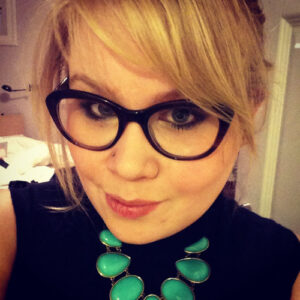
Anna Ficek is the inaugural postdoctoral fellow at SMU’s Custard Institute of Spanish Art and Culture at the Meadows Museum. A native of Katowice, Poland, she recalls a love for reading novels from an early age, particularly illustrated ones. In our interview, Ficek noted a quote she holds close to her heart from one of her favorite childhood novels, Alice in Wonderland, that states, “I’m sorry, but how can one possibly pay attention to a book with no pictures in it?”
Ficek noticed thereafter how she was always drawn to imagery, and eventually that love led to museums. Ficek’s interest in art history grew so much that she eventually attended courses at the University of South Australia within their visual arts department, particularly taking an interest in studio art and art history specialization. She graduated in 2011 with a BA in Visual Arts. During the program, Ficek studied abroad in Montreal at Concordia University. After graduation and finishing her studies in Canada, Ficek spent her time backpacking around Europe, seeking inspiration for what was next.
Later in 2011, Ficek moved to the Big Apple: New York City. It was there that Ficek really began to live out her artistic experience. She received an internship at the world-renowned Guggenheim Museum, and she ended up living and studying in New York City for over ten years. While at the Guggenheim, Ficek recalls working on an offsite project called stillspotting nyc. When I asked what this was, Ficek revealed that, “stillspotting was a project about capturing moments of stillness in urban life.” When asked why capturing stillness is important, Ficek advocates, “Stillness is difficult to find in a place like New York City. When we slow down, we’re able to take a moment to understand the city’s stories.” Of course, I was taken aback and in awe by this, but still skeptical about how the functionalities of “stillspotting” worked within a busy city like New York. Ficek explained that there were five iterations, one in each of the five boroughs of the city; each one worked with new artists, writers, and architects to capture the magic within a borough. She noted how each borough was unique and displayed the multicultural and ethnic parts of the city that made it and its inhabitants special. While each edition was different from the other, Ficek said the Manhattan edition was her favorite due to the classical music that was part of the experience. Arvo Pärt’s Hymn to a Great City played to visitors on the 46th floor of 7 World Trade Center.
After internships at several museums, Ficek decided to pursue her MA degree at Hunter College in 2014. During this period, Ficek was exploring the eighteenth-century images of colonial South American cities and received research funding to travel to Bolivia. She went on to write her dissertation for the CUNY Graduate Center on the subject of French images of the Incan empire, exploring how themes of colonial fantasy, race, and gender interact. Case studies such as “Letter of a Peruvian Woman” by Madame de Graffigny (1747) and “The Inca” by Jean-François Marmontel (1777) were highly influential in her research. She notes that she began writing her dissertation in January 2020, at the onset of the COVID-19 global pandemic, which affected her research and writing heavily through travel restrictions and the closing of museums, libraries, and archives.
To finish her dissertation, Ficek pursued fellowships from Brown University and Harvard University in 2021 and 2022, respectively. Most importantly, though, she received the Social Sciences Research Council’s International Dissertation Research Fellowship to conduct fieldwork in Europe. While based in Paris, she also traveled to the UK, Spain, and the Netherlands as part of the fellowship.
While teaching concurrently with her dissertation research, Ficek taught Introduction to Art History classes at Baruch College, Borough of Manhattan Community College, and the City College in New York. She also taught art history to American exchange students in Paris in 2022. Ficek received her PhD in 2023.
Later that same year Ficek joined the Custard Institute as its inaugural postdoctoral fellow. She is working as part of the digital humanities project Royal Power, Exoticism, and Technology: Porcelain Rooms from Naples to Madrid. This project examines two sites of cultural patrimony: the porcelain rooms built for the royal palaces at Portici (Italy) and Aranjuez (Spain). Both were commissioned by Carlos III, who was first the King of Naples (1735-1759) and then the King of Spain (1759-1788). The earliest of the two porcelain rooms, dismantled in 1866 and now on display at the Museo e Real Bosco di Capodimonte in Naples, was built for Carlos’ wife, Queen Maria Amalia. Maria Amalia was descended from Augustus II of Poland and Saxony, who founded the first porcelain manufactory in Europe. When Maria Amalia married Carlos, her dowry included large porcelain sets made at Meissen, her grandfather’s porcelain manufactory.
The first room was built as a porcelain salottino (small living room) for the Queen. The second room was also supposed to be for the Queen after Carlos and Maria Amalia moved to Spain (when Carlos became king of Spain), but she died before it was realized.
The project is using photogrammetry (a photographic process that translates two-dimensional data into three-dimensional renderings) to make a web-based model of the porcelain rooms and aims to eventually act as a repository for scholarship on them. The two digital models will serve as a tool and a platform for scholars. The project is a joint venture between the Custard Institute, the Edith O’Donnell Institute for Art History (EODIAH) at the University of Texas at Dallas, and other international partners.
Most recently Ficek traveled to the Historians of Eighteenth-Century Art and Architecture (HECAA) conference in Boston, where she presented an object-based gallery talk on eighteenth-century French silver. Afterward, Ficek traveled to Naples for ten days to visit the porcelain room at the Museo Capodimonte, as well as complete research at various cultural sites, museums, and libraries around the city. The public will get a taste of her writing in the forthcoming (September 2024) exhibition catalog The Legacy of Vesuvius: Bourbon Discoveries on the Bay of Naples, to which she has contributed an essay, “Porcelain Production and Bourbon Patronage in Naples.” Her fellowship is renewable for another year at the Custard Institute.
Written by Custard Institute for Spanish Art and Culture Communications Intern Gracie Holder.
If you have a comment, please email The Custard Institute.










